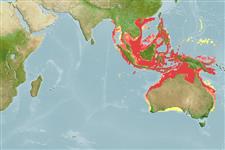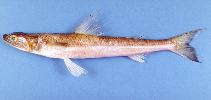Saurida undosquamis (Richardson, 1848)
Brushtooth lizardfish
Waarneming toevoegen in Fish Watcher
| Native range | All suitable habitat | Point map | Year 2050 |

|
| This map was computer-generated and has not yet been reviewed. |
| Saurida undosquamis AquaMaps Data sources: GBIF OBIS |
Uploaden van uw Foto's en video's
Pictures | Videos | Google afbeeldingSaurida undosquamis
Picture by Hermosa, Jr., G.V.
Pictures | Videos | Google afbeeldingSaurida undosquamis
Picture by Hermosa, Jr., G.V.
Israel country information
Common names:
[No common name]
Occurrence: questionable
Salinity: marine
Abundance: | Ref:
Importance: | Ref:
Aquaculture: | Ref:
Regulations: | Ref:
Uses: no uses
Comments: Species identification questionable, outside distributional range (Ref. 57869). The following repots may be referring to another species: a lessepsian migrant; first recorded from Haifa Bay in 1952 (Ref. 12815); displaced native species (Ref. 72453); speculated reason for success is its utilization of an unsaturated niche (Ref. 43448); average yearly catch from 1956-1962 was 262 tons (Ref. 6328).
National Checklist:
Country Information: https://www.cia.gov/library/publications/resources/the-world-factbook/geos/is.html
National Fisheries Authority:
Occurrences: Occurrences Point map
Main Ref: Inoue, T. and T. Nakabo, 2006
National Database:
Occurrence: questionable
Salinity: marine
Abundance: | Ref:
Importance: | Ref:
Aquaculture: | Ref:
Regulations: | Ref:
Uses: no uses
Comments: Species identification questionable, outside distributional range (Ref. 57869). The following repots may be referring to another species: a lessepsian migrant; first recorded from Haifa Bay in 1952 (Ref. 12815); displaced native species (Ref. 72453); speculated reason for success is its utilization of an unsaturated niche (Ref. 43448); average yearly catch from 1956-1962 was 262 tons (Ref. 6328).
National Checklist:
Country Information: https://www.cia.gov/library/publications/resources/the-world-factbook/geos/is.html
National Fisheries Authority:
Occurrences: Occurrences Point map
Main Ref: Inoue, T. and T. Nakabo, 2006
National Database:
Common names from other countries
Classificatie / Names Lokale namen | Synoniemen | Catalog of Fishes(Genus, Soort(en)) | ITIS | CoL | WoRMS | Cloffa
> Aulopiformes (Grinners) > Synodontidae (Lizardfishes) > Harpadontinae
Etymology: Saurida: Derived from Greek, sauros = lizard (Ref. 45335).
More on author: Richardson.
Etymology: Saurida: Derived from Greek, sauros = lizard (Ref. 45335).
More on author: Richardson.
Issue
Distribution needs major revision due to questionable (unconfirmed) occurences reported by major references (Ref. 57869:385-6).
Environment: milieu / climate zone / depth range / distribution range Ecologie
marien rifbewoner; amfidroom (Ref. 51243); diepte 1 - 350 m (Ref. 38189). Subtropical; 45°N - 44°S, 89°E - 154°E
Verspreiding Landen | FAO regio's | Ecosystemen | Voorkomen | Point map | Introducties | Faunafri
Eastern Indian Ocean, Malay Peninsula, southern Philippines, northern Java, Arafura Sea, Louisiade Archipelago, and northern half and southwestern Australia. Reports of Introduction in the Mediterranean are questionable. Confirmed and questionable reports of its occurrence (and references) are discussed in Inoue & Nakabo 2006 (Ref. 57869:385-6).
Lengte bij maturiteit / Grootte / Gewicht / Leeftijd
Maturity: Lm 19.8 range ? - ? cm
Max length : 50.0 cm SL mannelijk / geslacht onbekend; (Ref. 3397); common length : 30.0 cm TL mannelijk / geslacht onbekend; (Ref. 5450); max. gerapporteerde leeftijd: 7 Jaren (Ref. 94612)
Max length : 50.0 cm SL mannelijk / geslacht onbekend; (Ref. 3397); common length : 30.0 cm TL mannelijk / geslacht onbekend; (Ref. 5450); max. gerapporteerde leeftijd: 7 Jaren (Ref. 94612)
Korte beschrijving Determinatiesleutels | Morfologie | Morfometrie
Dorsale stekels (totaal) : 0; Dorsale zachte stralen (totaal) : 11 - 12; Anale stekels: 0; Anale zachte stralen: 11 - 12. Cigar-shaped, rounded or slightly compressed; the head pointed and depressed; the snout rounded. Dorsal origin closer to the adipose origin than the snout tip. Anal fin origin is closer to the tail base than the operculum. Color is brown-gray above and creamy below, with 8-10 indistinct darker spots along the middle of the sides.
Found on the sublittoral zone above 100 m over sand or mud bottoms of coastal waters (Ref. 11228, 11230). Feeds on fishes (anchovy and red mullet Mullus surmuletus), crustaceans, and other invertebrates (Ref. 5213). Spawns from April to May off Japan. Generally marketed frozen, sometimes fresh and as fish cakes ('kamaboko') in Japan (Ref. 4964). Minimum depth from Ref. 12260.
Levenscyclus en paargedrag Maturiteit | Voortplanting | Paaien | Eieren | Fecunditeit | Larven
Hoofdreferentie
Upload your references | Referenties | Coördinator | Medewerkers
Russell, B.C., 1999. Synodontidae: lizardfishes (also bombay ducks, sauries). p. 1928-1945. In K.E. Carpenter and V.H. Niem (eds.) FAO species identification guide for fishery purposes. The living marine resources of the Western Central Pacific. Vol. 3. Batoid fishes, chimaeras and bony fishes. Part 1 (Elopidae to Linophrynidae). FAO, Rome. pp. 1397-2068. (Ref. 38189)
Status op de Rode Lijst van het IUCN (Ref. 130435: Version 2024-2)
Niet bedreigd (LC) ; Date assessed: 02 March 2015
Gevaar voor de mens
Harmless
Gebruik door de mens
Visserij: van minder commercieel belang
FAO(visserij: productie; publication : search) | FishSource | Sea Around Us
Meer informatie
Population dynamics
Groeiparameters
Max. ages / sizes
Length-weight rel.
Length-length rel.
Lengtefrequenties
Massaconversie
Rekrutering
Abundantie
Groeiparameters
Max. ages / sizes
Length-weight rel.
Length-length rel.
Lengtefrequenties
Massaconversie
Rekrutering
Abundantie
Life cycle
Voortplanting
Maturiteit
Fecunditeit
Paaien
Spawning aggregations
Eieren
Ontwikkeling van de eieren
Larven
Larvale populatiedynamiek
Voortplanting
Maturiteit
Fecunditeit
Paaien
Spawning aggregations
Eieren
Ontwikkeling van de eieren
Larven
Larvale populatiedynamiek
Physiology
Body composition
Nutrients
Zuurstofverbruik
Zwemtype
Zwemsnelheid
Visual pigments
Fish sound
Diseases & Parasites
Toxicity (LC50s)
Body composition
Nutrients
Zuurstofverbruik
Zwemtype
Zwemsnelheid
Visual pigments
Fish sound
Diseases & Parasites
Toxicity (LC50s)
Human related
Aquaculture systems
Aquacultuurprofielen
Kweeklijnen
Ciguatera cases
Stamps, coins, misc.
Aquaculture systems
Aquacultuurprofielen
Kweeklijnen
Ciguatera cases
Stamps, coins, misc.
Tools
E-boek | Veldgids | Determinatiesleutels | Lengtefrequentie Tool | Levenscyclus tool | Verspreidingskaart | Classification Tree
| Catch-MSY |
Speciale rapporten
Bekijk gegevens voor het houden in een aquarium | Bekijk Fact Sheets voor de soort | Bekijk Aquacultuur Fact Sheets
Download XML
Internetbronnen
Exoten/Invasieve soorten database | Aquatic Commons | BHL | Cloffa | BOLDSystems | Websites from users | Bekijk FishWatcher | CISTI | Catalog of Fishes(Genus, Soort(en)) | DiscoverLife | ECOTOX | Faunafri | Fishtrace | GenBank(genoom, nucleotide) | GloBI | GOBASE | | Google Books | Google Scholar | Google | IGFA World Record | MitoFish | Nationale databanken | Otolith Atlas of Taiwan Fishes | PubMed | Reef Life Survey | Scirus | SeaLifeBase | Tree of Life | Wikipedia(ga naar, zoek) | World Records Freshwater Fishing | Zoological Record
Estimates based on models
Preferred temperature (Ref. 115969): 18.8 - 27.9, mean 26 (based on 583 cells).
Fylogenetische diversiteitsindex (Ref. 82804): PD50 = 0.5000 [Uniqueness, from 0.5 = low to 2.0 = high].
Bayesian length-weight: a=0.00550 (0.00478 - 0.00632), b=3.10 (3.06 - 3.14), in cm Total Length, based on LWR estimates for this species (Ref. 93245).
Trofisch niveau (Ref. 69278): 4.5 ±0.4 se; based on diet studies.
Weerstandsvermogen (Ref. 120179): Gemiddeld, minimale populatieverdubbelingstijd 1,4-4,4 jaar (K=0.3-0.9; tm=1-2; tmax=8; Fec=84,802).
Fishing Vulnerability (Ref. 59153): Moderate vulnerability (39 of 100).
Climate Vulnerability (Ref. 125649): Low vulnerability (25 of 100).




